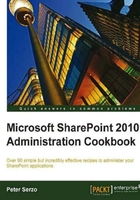
In this chapter, we will cover:
- Checking current installation upgradeability
- Upgrading MOSS 2007 to SharePoint 2010
- Upgrading with minimal downtime
- Visual upgrade
- Creating and associating content databases to a specific web application and site collection
- Configuring a content database
- Creating an Alternate Access Mapping (AAM)
- Patching (compatibility boundaries)
SharePoint 2010 requires 64-bit architecture on the servers, with a minimum of 8 gigabytes of RAM. The result of this requirement is that there will be installations upgrading their 32-bit architecture and then upgrading/migrating their sites.
Upgrading SharePoint 2010 is optimally a one time job. In reality, this is not always the case as there may be business reasons one web application is upgraded and another is left in MOSS 2007. This could be due to software integration with SharePoint, components that are not ready for SharePoint 2010, or a segment of users that need time before upgrading to SharePoint 2007.
SharePoint 2010 has been architected with the capability to migrate sites methodically. With this in mind, every recipe in this chapter approaches the upgrade from the viewpoint of iterative tasks after an upgrade. This means that a majority of the tasks can be performed several times against different web applications.
Every recipe here (except the first one) should be performed and understood by the administrator of the SharePoint 2010 farm. There are many new items in SharePoint 2010 that will become common tasks; some more than others depending on the size of your environment.
One of the best new tools that should be in your arsenal is PowerShell. The recipes in this section outline the commands you will need. However, after reviewing and trying these recipes, look at scripting your tasks with PowerShell. This will enable you to become a more effective and proactive IT Professional.